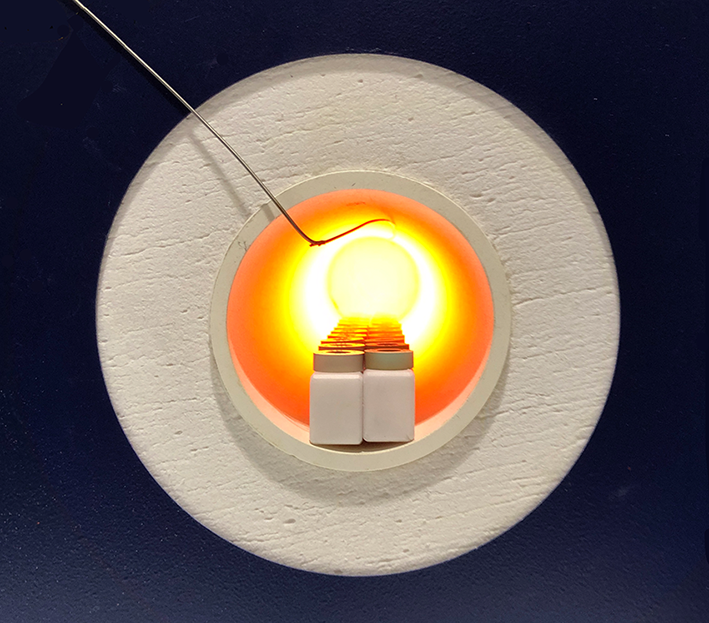An important concern in ICME is the determination of predictive uncertainty, which requires careful validation of the computer models used. At Fraunhofer Center HTL, methods for experimental validation of computer simulations and for determining predictive uncertainty are being developed. The approach is based on the simulation task and is described below for the four important areas of input data, microstructure-property simulation, simulation of heat treatment processes, and digital twins of production furnaces.
Model Validation
The measurement uncertainty of experimentally determined data is determined in the usual way from the standard deviation in repeat experiments and the estimation of systematic measurement deviation (DIN1319-3). The confidence interval of input data taken from databases is estimated by comparison with known data or calculated from the variation of the respective value in different sources. Scripts created at the HTL are used for the automatic evaluation of numerous data sources. When processing the data with analytical models, error propagation is calculated according to DIN1319-4. Statistical methods are used to determine parameter uncertainty when determining model parameters by fitting procedures. Sensitivity analyses are used when processing the data in simulation programs to determine the effects of its uncertainties on the simulation result.
The validation of the simulation is carried out in two stages. First, it is checked whether the generated microstructure models accurately correspond to the microstructures of real materials. For comparison, chord length analyses are carried out on both synthetic representative volume elements (RVE) and binarized cross-sectional images of real materials. The latter are usually obtained from scanning electron microscopy images of polished sections using in-house algorithms. With the chord length analyses, all relevant structural features can be checked: phase fractions, interfacial fractions, size distributions. Once the correct representation of the real structure is ensured, the material properties of the RVE are calculated in an FE model. After homogenization, they are compared with the material properties measured on the real material. As a rule of thumb, deviations are within a few percent for accurate input data. However, the material properties of individual phases and interfaces are often insufficiently known. In this case, inverse simulation methods are used to determine the input data and to reduce the predictive uncertainty.
The local material changes in the component that occur during the heat treatment process are described by a kinetic model. This model is based on in-situ measurement data obtained from specialized measuring furnaces. The so-called Kinetic-Field method has proven particularly suitable for deriving robust predictions from measurement data. The in-situ measurement quantity is selected as the material property that can capture the relevant material change with the highest resolution. For gas-phase reactions, this is often the weight change of a sample, and for sintering processes, it is the dimensional change. The data basis is created through simple temperature-time cycles, e.g., with different constant heating rates. Measurement uncertainties are extracted from the noise in the in-situ measurement data. Then, so-called isolines are determined, which connect all points at the same reaction level according to simple, mostly linear models. The confidence interval of the parameters for describing the isolines is determined from the measurement uncertainty of the primary data. The validation of the kinetic models is carried out by comparing experiments and simulations in randomly generated temperature-time cycles. The scaling up of the heat treatment to component size is performed using finite element simulations. It requires additional material properties that depend on temperature and reaction level and are subject to measurement uncertainties. Here, as well, model uncertainties can be determined through sensitivity analyses if necessary. The validation of the simulations is carried out at the HTL's thermooptical measuring furnaces by conducting in-situ measurements on large samples and comparing them with the predictions from the simulation.
The central task of the digital twin is heat management within production furnaces. The furnace models must accurately consider heat transfer by conduction, radiation, and convection. The first step in creating a reliable model is the collection of high-temperature data for the furnace materials. Therefore, at the HTL, measurement methods are developed to accurately capture thermophysical material properties even at high temperatures. The measurement volumes are adjusted to allow for the representative measurement of heterogeneous materials typical in refractory applications. Examples include thermal conductivity and emissivity. If necessary, the measurement data are supplemented by literature data or manufacturer specifications. In the second step, the simulation of individual heat transfer mechanisms is validated. For this purpose, special test rigs are developed at the HTL, including:
- a radiation channel for radiation heat transfer with flexibly arranged radiation barriers
- a flow channel for convective heat transfer with flexibly arranged flow barriers
- a heat flux testing facility for measuring heat conduction in multi-layered furnace insulation.
In the final step, the digital twin of the furnace is validated on continuous or discontinuous production furnaces by comparing the simulation results with sensor data from the real furnaces. The mobile furnace testing facility of the HTL can be used for measurement purposes.
Service Offering:
- Determination of confidence intervals for material data
- Conducting sensitivity analyses as needed
- Determination of forecast uncertainties as needed
 Fraunhofer ISC, Center for High Temperature Materials and Design HTL, Bayreuth
Fraunhofer ISC, Center for High Temperature Materials and Design HTL, Bayreuth
